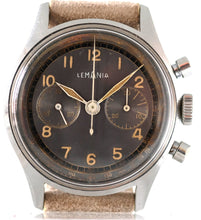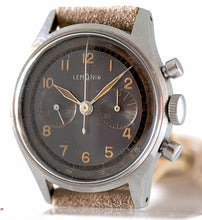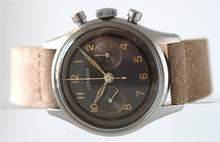
Lemania Chronograph with two tone dial . Fine, stainless steel, water-resistant wristwatch with round-button chronograph and register.
Case: Two-body, solid, polished and brushed, inclined bezel, concave downturned lugs, screw-down stainless steel back.
Dial: Two-tone grey and black dial with radium Arabic numerals, outer gilt minute/seconds and 1/5th seconds divisions, gilt faded Tachymeter scale, gilt subsidiary dials for the seconds and the 30-minute register. white radium sword hands. Dial is beautifully patinated.
Movement: Cal. 1275, rhodium-plated, 17 jewels, straight-line lever escapement, monometallic balance, self-compensating blued steel flat balance spring, shock absorber, index regulator.
Circa: 1950's
Diameter: 35.5mm Thickness: 12mm
More about Lemania:
Alfred Lugrin was born and raised in Switzerland in the mid-19th Century, and early on started working for various watch companies designing chronograph movements. He founded his own company, called A. Lugrin S.A. in 1884, and enjoyed much success. Known for his innovative chronograph movements, Albert patented one of the movements (Brevet No. 359) and started to win awards for his designs.
In 1918, the Lemania Watch Company was created, and soon after in 1920 Alfred’s son-in-law Marius Meylan became the managing director. In 1932 Meylan purchased the Lemania company and would continue to market watches and movements under that name.
One of Lemania’s most well known movements was adopted by Omega for their chronographs, chosen for its shock protection and anti-magnetic balance spring. Introduced first in 1946 as the caliber 321, Omega went on to use this legendary caliber in its Speedmaster models. Omega would later use the updated Lemania 1873 as the basis for the Omega caliber 861. With the international recognition from the Omega Speedmaster as the first watch worn on the moon, Lemania’s chronograph movements began to appear in watches produced by Audemars Piguet, Breitling, and Patek Philippe, among others.
With the popularity of its manual-wind, 17 jewel movements, Lemania was slow to start producing automatic chronographs. Nevertheless, in 1978 Lemania introduced the caliber 5100, which was used by Heuer, Omega, and Sinn among others, often for military-issued watches. For the next twenty years, the ownership of Lemania changed hands several times, finally becoming part of the Swatch Group through their purchase of Breguet. Their movements are still used today in many Breguet watches.
The present watch is a rare example of a Lemania chronograph with beautifuly patinated dial with its original intact rodium numerals. It features a charismatic dial with rings of dark gray and black, telemeter scale, and a crisp case with sharp facets. This combination of attributes is a rare opportunity for vintage chronograph collectors to acquire an extraordinarily and well-preserved specimen.


























